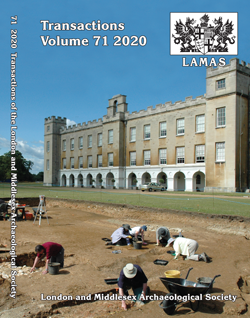Transactions of the London & Middlesex Archaeological Society
Volume 71 - 2020
The articles will become availabe for download in December 2024
List of Contents
Roman burials from the London Fruit and Wool Exchange redevelopment, Spitalfields, London E1
Elizabeth L Knox, Adrian Miles and Beth Richardson
Part of the north London’s Roman extra-mural cemetery was revealed during this recent redevelopment of the former market, another article describes the post-medieval slums that latterly occupied the site (see below).
The Bishop of London’s medieval palace moat in Fulham High Street and Fulham Stream: their management history including post-medieval reclamation and urban development
Douglas Killock, Matt Edmonds and Damian Goodburn
An infilled arm of the medieval moat that still encircles the bishop's palace was discovered, during the post-medieval period this low-lying area of the Thames flood plain was reclaimed and built over.
Syon Abbey: archaeological investigations in Syon Park, Brentford, 1997–2018
Robert Cowie
The article (which is features on the cover) is the final report on the extensive investigations of England’s only medieval Bridgettine monastic house, it is often described as a nunnery, but as it housed both men and women this description is a little misleading. Despite a relatively late foundation date (1415) royal patronage ensured that Syon Abbey was both wealthy and successful. It was suppressed in 1539, but was briefly refounded during the Roman-Catholic revival of Queen Mary’s reign before closing permanently and becoming the residence of the dukes of Northumberland.
‘Protect me who gave thee birth’: Thomas Becket on medieval London seals
Elizabeth New
St Thomas Becket was a Londoner, who became Archbishop of Canterbury and following his brutal murder in 1170, he was immediately declared a martyr and quickly canonised. He became a very popular saint particularly in his home city. So as part of the events commemorating the 850th anniversary of his death we look how medieval Londoners used his image on their documents.
London’s ‘little company’ of glovers
Peter Brown
The article follows the rise of this medieval craft group and religious fraternity, which was established in 1349 and in 1502 merged with the Leathersellers’ Company. In 1639 it became the Glovers’ Company of London.
Further evidence for the Abbey of St Clare and later occupation at 24–26 Minories, EC1: an addendum
Antonietta Lerz
See article in LAMAS Trans 69 (2018)
The ninth Earl of Northumberland’s equestrian interests and his construction of an haute école riding arena at the Tower of London
Robert A Jackson
In 1606 Henry Percy, the Ninth Earl of Northumberland was sentenced to life imprisonment in the Tower of London for alleged complicity in the Gunpowder Plot. He was detained until 1621. Whilst imprisoned in the Tower the earl enjoyed a relatively luxurious lifestyle and he was able to modify his environs. The earl was a passionate equestrian and during 1609–11, he constructed a riding arena within the Inmost Ward of the Tower, for the purposes of haute ecole training.
17th-century glass-working waste from Broadgate, London EC2
Colin Brain, Andrew Meek and Jacqui Pearce
A large quantity of 17th-century glass-working waste recovered during excavation of the New Churchyard (Bethlem Burying Ground) in Broadgate may be derived from the Old Bedlam glasshouse, first recorded in 1696.
Looking beyond the Ripper: reconstructing Dorset Street and White’s Row, Spitalfields, London E1, an archaeological history of two East End streets, 1673–1927
Nigel Jeffries
By the 19th century this formerly prosperous London suburb had become a slum and was occupied by common lodging houses or properties in multiple occupancy. Using a combination of detailed documentary research, the fragmentary building remains and the assemblages of domestic artifacts recovered from external features like cesspits the living conditions and material culture of these relatively poor and transient Victorians has been reconstructed.
The slave trade and emancipation recalled by street names in Camden Town, London NW1
Mark McCarthy
Economic and social aspects of the colonial slave trade and emancipation are evoked through the surnames in the street names of this north London suburb.
Reviews
- Fifty Years of London’s Archaeology: Papers from the 50th Anniversary Conference of London Archaeologist
- Later Prehistoric and Other Discoveries in the Thames Valley and on the Surrey Greensand
- A Bath House, Settlement and Industry on Roman Southwark’s North Island: Excavations along the Route of the Thameslink Borough Viaduct and at London Bridge Station (Bridging the Past: Life in Medieval and Post-Medieval Southwark: Excavations along the Route of Thameslink Borough Viaduct and at London Bridge Station (reviewed by Brian Ayers)
- St Paul’s Cathedral Precinct in Early Modern Literature and Culture: Spatial Practices
- London Parish Maps to 1900: A Catalogue of Maps of London Parishes within the Original London County Council Area
- Manufactured Bodies: The Impact of Industrialisation on London Health
- Migrant City: A New History of London
- A Mighty Capital under Threat: The Environmental History of London, 1800–2000
- Survey of London 53: Oxford Street
- The Thames at War


